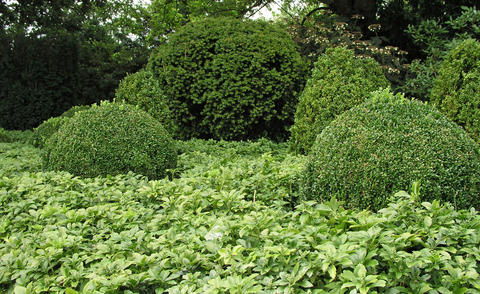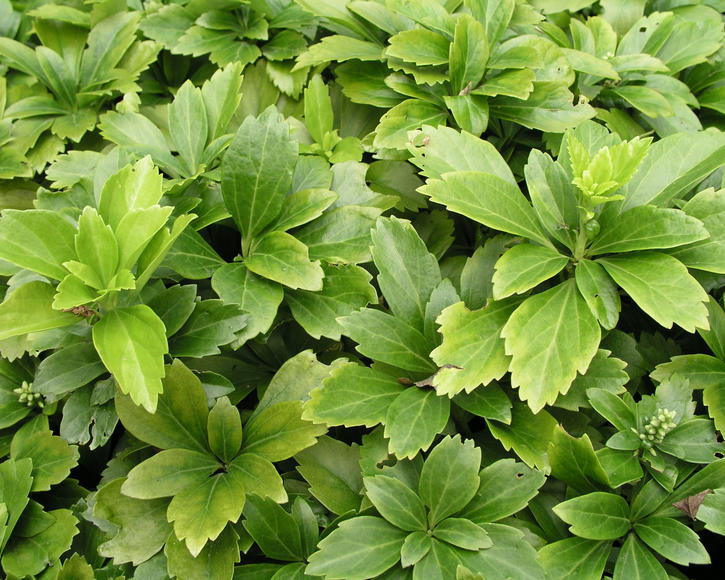Japanese pachysandra
The Japanese pachysandra, or Japanese spurge, adds a wonderful splash of green to shady spaces under trees. How to plant and care for the shrub.
Factsheet
- Growth type
-
- Small shrub
- half shrub
- rhizome
- Growth height (from)
- from 15 cm to 30 cm
- Growth width (from)
- from 15 cm to 30 cm
- Growth characteristics
-
- flat growing
- carpet forming
- foothills
- tight
- Flower color
-
- white
- Flowering time (month)
-
- April to May
- Flower shape
-
- ear-like
- Flower characteristics
-
- lightly fragrant
- monoecious
- Leaf color
-
- green
- page format
-
- lancéolées
- Sheet properties
-
- evergreen
- Fruit shape
-
- Capsule
- Light
-
- semi-shade to shady
- Soil type
-
- sandy to loamy
- Soil Moisture
-
- fresh to moderately humid
- ph value
-
- neutral to weakly acidic
- Lime compatibility
-
- sensitive to lime
- Nutrient requirements
-
- nutrient-rich
- Humus
-
- rich in humus
- Decorative or utility value
-
- Flower Decoration
- Leaf ornaments
- Toxicity
-
- toxic
- Winter Hardness
-
- hardy
- Climate zones according to USDA
-
- 5
- areas of life
-
- G2
- GR2
- Use
-
- ground cover
- Grave planting
- Group planting
- Underplanting
- Garden style
-
- Formal garden
- Rhododendron garden
- Forest Garden
The Japanese pachysandra (Pachysandra terminalis), also known as the Japanese spurge, is a dense, prolific groundcover plant, which belongs to the boxwood (Buxaceae) family. It originates from the humid forests of Japan and China. The flowers of the Japanese pachysandra consist of very thick filaments. It has thick anthers. There are around four to five evergreen and semi-evergreen dwarf shrubs or sub-shrubs in this genus. Pachysandra terminalis is by far the most frequently planted type and the most used a ground coverage over large areas.
The persistent Japanese pachysandra grows to a height of 5.91 to 12 inches. It spreads slowly and extensively through its creeping rhizomes and its underground spurs. The Japanese pachysandra covers bare ground areas with a thick, evergreen leafy carpet. All parts of the plant contain poisonous alkaloids.
The derb leathery leaves of Pachysandra terminalis have a lanceolate shape, are notched at the end and grow to about 2.36 to 3.94 inches long. They have a deep, green shine and stand at short distances on low shoots which lignify to the ground. The Japanese pachysandra is evergreen - the leaves may turn yellowish in strong sunlight.
Tiny, white flowers in short, upright heads appear on the end of the Japanese pachysandra shoots from April to May. They do not have petals and only consist of very thick filaments. Several inconspicuous female flowers with a green shade sit underneath the numerous male flowers.

The inconspicuous fruit capsules of the Japanese pachysandra are just 0.39 to 0.79 inches long.
Japanese pachysandra prefer a semi-shady to shady location. The plants root-pressure resistant and tolerate urban climates.
Japanese pachysandra is happiest in loose, slightly acidic, humus soil. The earth should be kept as fresh as possible and moderately damp with very little lime content. However, the soil should also not be too acidic as this has a negative impact on growth.
To ensure strong root growth, plant the Japanese pachysandra rhizomes flat in very loose soil. Plant around 8 to 12 plants per square meter to provide green coverage in spacious areas.
Pachysandra is extremely low maintenance and frost-hardy. However, in heavy droughts the plants should be regularly watered.
Annual pruning is not required with the Japanese pachysandra. If the small shrubs become too tall or abundant you can simply cut them with hedge trimmers after they bloom in April and May. You can prune bare shoots flat to the ground level and dig up wayward spurs.

The Japanese pachysandra thrives between and under shrubs and in shaded, open areas. Planted flat, the semi-shrub can accommodate and process an unbelievable amount of foliage. The ‘Green Carpet’ variety is particularly recommended for smaller gardens. In general, the Japanese pachysandra is not combined with other shrubs, but planted in unmixed varieties and types. This enables it to create the effect of a beautiful, calming background for flowering shrubs with strong colors. However, it also looks fantastic in combination with Zeblid (Leucothoe walteri) and . If it is not too shaded, pachysandra spaces can be embellished with Spanish bluebells (Scilla campanulata) and Corydalis. Japanese pachysandra is recommended for planting in flower beds and provides excellent cut greenery for smaller bouquets.
The slow-growing ‘Green Carpet’ variety with a height of approx. 5.9 inches is extremely suitable for adding greenery to small areas in semi or full shade. Its leaves are smaller and narrower than in the variety. Pachysandra terminalis ‘Variegata’ is also slower-growing than the variety. Its leaves are a real show-stopper: They have irregular white-yellow edges and fine, white veining.

You can divide the pachysandra during the spring or fall . Propagation is preferable from May to June with approx. 2.8 inches long head cuttings. Cutting propagation is possible later, however the hardened shoots no longer take root so readily.
If the ground is too calcareous, chlorosis or anemia can occur in Japanese pachysandra.

